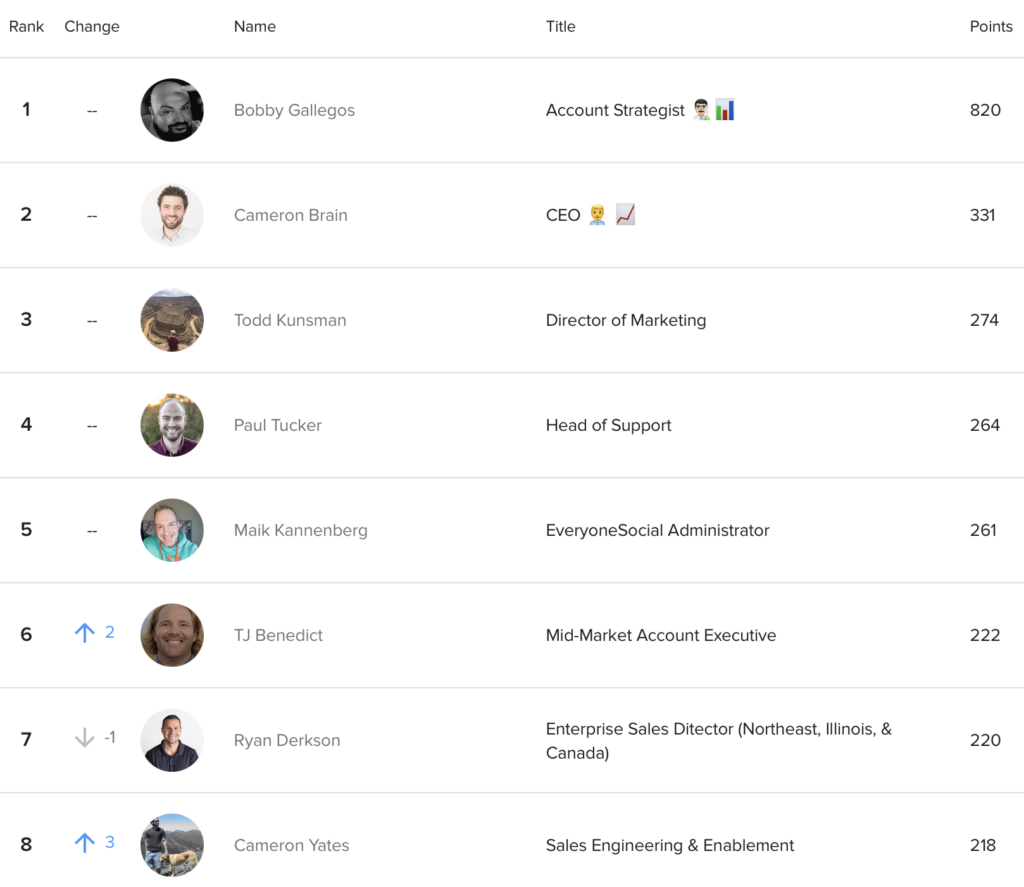Employee advocacy is often associated with enterprise companies, those with thousands of employees and large budgets to devote to advocacy efforts.
And there’s plenty of big-name brands — Facebook, T-Mobile, and American Family Insurance, just to name a few — that recognize employee advocacy’s value and use EveryoneSocial to enable their people to create and share content.
But advocacy isn’t for enterprise companies alone. Nor do you need a massive budget to be successful and reap the benefits.
Organizations of all sizes benefit from getting their teams active and engaged on social media.
Let’s take a look at how a pure play advocacy solution like EveryoneSocial can transform small and mid-market companies, as well as the advantages these teams have and tips for advocacy success.
Employee Advocacy Benefits
Implementing and building an employee advocacy program has countless benefits for organizations of all sizes, but let’s dive into how they’re particularly beneficial to smaller and midmarket companies.
Higher employee engagement
When workers have more access to company information, they’re more engaged and they work harder as a result.
And when they’re trusted to be the face of the brand to their personal networks, it fosters a sense of ownership that further increases employee engagement.
Increased growth and profitability
Highly engaged teams have 21% greater profitability. Plus, organizations with an employee advocacy program in place are more than twice as likely as to be high-growth companies: those with revenue growth greater than 20%.
Greater brand reach and engagement
When employees share company news and content to their personal social networks, it increases brand awareness by more than 500%. And this employee-shared content receives eight times more engagement than that shared by brand channels.
Lower marketing costs
With all this sharing and engagement, company messaging reaches tons of prospective customers organically, saving on marketing spend.
In fact, EveryoneSocial customers generated more than $200 million in media value in just the first half of 2021 alone, and they saved money because their employees drove clicks and engagement at a fraction of the cost of paid social ads.

Better employee branding
Seventy-five percent of job seekers take employer brand into consideration before applying for a job, and candidates trust a company’s actual employees three times more than the company itself.
So empowering team members to post about the company on social media helps build an authentic, trustworthy employer brand.
And that means you’ll attract more top talent — at a fraction of the cost.
Improved social selling
When employees themselves share your content, it increases prospective customers’ trust in your brand, making social selling easier. That means better you get higher-quality leads, better win rates, and a shorter sales cycle.
Sixty-four percent of businesses with advocacy programs in place credit them with attracting new business, and social selling through a platform like EveryoneSocial drives up to 48% larger deals.
Advantages of Implementing Advocacy on Smaller Teams
Your organization may not have all the resources of a large corporation, but there are upsides to launching an advocacy program at a smaller company. Let’s take a look.
Fewer people are required to get buy-in.
When you decide to implement an employee advocacy program — whether you’ll manage it manually or through an all-in-one solution like EveryoneSocial — it may be as simple as making the decision yourself.
However, even if you require approval from a supervisor or department head, there’s still much less red tape than if you attempted to launch such an initiative at an enterprise organization.
You’ll get faster results.
The sooner you launch an employee advocacy program, the sooner you’ll reap the benefits from it.
You’ll see results — including increased social media engagement and reach — almost immediately as team members begin sharing content with their personal networks.
And as your company grows, you can make it a part of the onboarding experience. It’s easy to establish a socially active culture among employees when you start from day one.
Employees are more likely to share content.
Implementing an employee advocacy solution like EveryoneSocial is proven to increase sharing, and smaller teams may experience an even greater number of shares.
Why? Because employees are more likely to be well acquainted with their co-workers and therefore more likely to share their posts.
In fact, research shows that people aren’t only more likely to trust content from people they know, but they’re also more likely to share it themselves.
How to Get the Most out of Employee Advocacy at Your Company
Follow these four tips to ensure your advocacy initiatives are a success.
1. Foster a culture of advocates.
There’s a reason why Kathleen Reidenback, Kimpton Hotels & Restaurants’ chief commercial officer, says “investing in workplace culture” is in companies’ best interest. “We’ve found that the employees who experience high levels of satisfaction work smarter and harder and take greater pride in a job well done,” she says. “They’re the ultimate brand advocates.”
To get employees sharing company content and truly advocating on the brand’s behalf on social media, they first need to be satisfied, engaged workers. And that begins with company culture.
Does your workplace culture need some work? Implement the steps outlined here to build a culture of brand champions.
2. Highlight the benefits to employees.
Employee advocacy is no doubt beneficial to companies, but if you want your people to create and share content about their employer, they need to understand how it benefits them.
Luckily, involvement in advocacy efforts has advantages for individual employees, allowing them to grow their networks and empowering them to build their personal brands.
A Social Media Today survey of nearly 600 people, 86% of respondents said involvement in an employee advocacy program positively impacted their career by connecting them to new people, increasing their visibility, and helping them stay up to date on industry trends and develop their skills
So when you launch your advocacy efforts, show employees how their involvement directly benefits them and give them solid reasons to start creating and sharing.
3. Provide social media training.
Not everyone understands social media or is comfortable using it — especially when it comes to talking about their employer.
In fact, nearly 75% of workers say they haven’t received any training on how to engage professionally on social media and half of workers say their companies don’t have an employee social media policy in place. Yikes.
These days, it’s essential to provide employees with clear social media rules, as well as basic training on how to use social media.
What do employees want to learn? According to the Social Media Today survey, these topics topped the list:
- How to foster engagement
- Training for specific social channels
- Content marketing strategy
- How to generate and nurture leads
- How to become a brand advocate
4. Incentivize employees to share.
Growing their network and developing a personal brand might be all the motivation some workers need to be active in an employee advocacy program. But others may need a little more incentive.
That’s why EveryoneSocial has customizable leaderboard and gamification features that reward users for participation.

Some of our customers take things a step further and offer prizes to top users for further incentivization.
Ed-tech company Instructure, for example, which has about 1,200 employees rewards its people’s social-sharing efforts with gift cards and iPads. This effective strategy enabled the organization to grow content shares by an astounding 3,846% in just two months. Read the case study.
Get Started with EveryoneSocial Today For Free
One of the chief reasons that small and midmarket businesses hesitate to launch employee advocacy programs is the cost associated with it.
However, transforming your employees into brand advocates doesn’t have to be a pricey investment.
In fact, EveryoneSocial has a Teams plan (pay for the amount of users you want) or if you just want to test the waters, try our free forever plan.
What are you waiting for!?
















